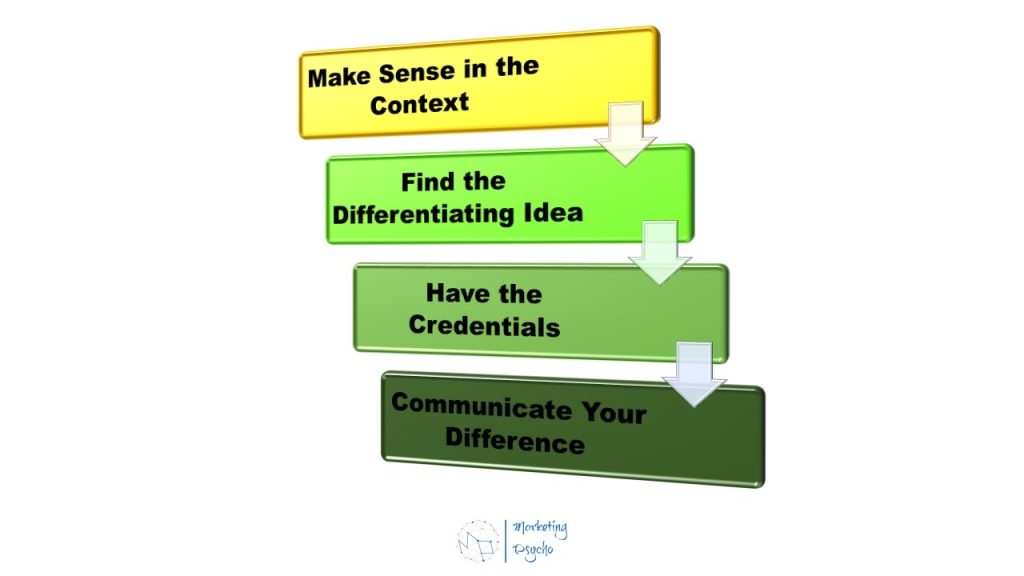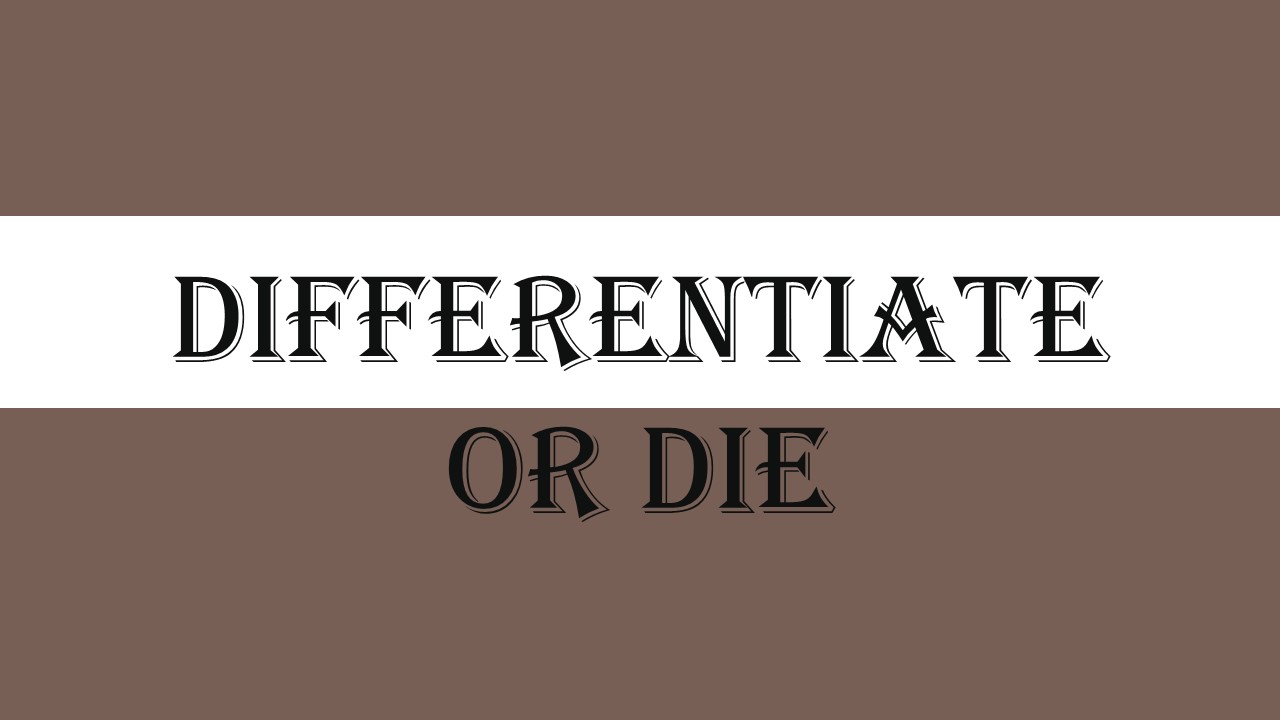The book “Differentiate or die!”, written by Jack Trout in collaboration with Steve Rivkin, reveals different ways to stand out among a large number of competitors and at the same time not get into a situation where marketing efforts are aimed at imaginary differences, in other words, when many things seem different, but in fact, they are not.
The modern market is saturated with a large number of goods, in this regard, consumers are constantly faced with a choice. But is it good or not when there is such a variety around? On the one hand, a wide choice is attractive, but on the other hand, people are too overwhelmed with so much information and therefore often postpone making a decision.
What drives the choice? According to the authors, this is The Law of Division that has been described by Al Ries and Jack Trout in the book “The 22 Immutable Laws of Marketing”. Over time, a category will divide and become two or more categories. At first, there is one category, but over time it is divided into several segments. Each segment is a separate market where there may be a leader other than the original category. Categories are divided, not combined. The Law of Division has led to the formation of a whole business that helps people in their choice, for example, the compilation of ratings.
Differentiation will help your client make a choice. This is your trump card in the fight for the consumer.
Jack Trout and Steve Rivkin say that differentiation as a phenomenon already exists, but many marketers do not fully understand the rules of the game. They often focus on insignificant values or values that identical goods possess and are already used. This is the wrong approach. It is necessary to find and highlight those values that can take a place in the consumer’s mind and that will belong only to you. You will be able to convey this information to your audience with the help of a Unique Selling Proposition (USP).
Unfortunately, specialists have been paying little attention to USP lately. If you are advertising a product, you must give the consumer a reason to choose it. The reason should be the difference. But many marketers think that most products are too similar to each other, so they do not bother looking for radical solutions, but choose an easier path based on minor differences. But the authors are against such a position, they advise to act big or not bother with it at all.
Jack Trout and Steve Rivkin list several variants of differences that are most often used by marketing specialists, but which rarely bring the desired result (although they do not exclude that in some cases these ideas may be useful). Here they are:
- Quality
- Customer Orientation.
- Creativity
- Price
- Breadth of Line
The authors describe a four-stage differentiation process. It consists of the following steps.

Step 1: Make Sense in the Context
Your message should make sense in the context of the category. You have to analyze how people already perceive the product.
Step 2: Find the Differentiating Idea
You should be looking for something that distinguishes you from your competitors and that benefits your consumer, while your difference does not necessarily have to be related to the product.
Step 3: Have the Credentials
When you have found your unique difference, you must confirm it. Statements about differences without evidence are just statements. The message must be honest, otherwise, people will stop believing you.
Step 4: Communicate Your Difference
Your advertising, your brochures, your website – all the communication channels that you use to convey your statement of difference should be interconnected and carry one idea. You need to create a program that allows people to realize your difference. This stage refers to the positioning of the product.
The term positioning was first used by Jack Trout in 1969 in the article “Positioning is a game people play in today’s me-too marketplace” in the magazine “Industrial Marketing”. Then in 1972, he and Al Ries published a series of articles called “The Positioning Era” in the magazine “Advertising Age”, which are devoted to the concept of positioning. Then their joint work is published – the book “Positioning: The Battle for Your Mind”. According to the authors, positioning is an activity with a position in the minds of consumers.
In modern society, a person is subjected to a mass attack with information. A large information field is formed around it, in which it is difficult to understand which data is useful and necessary, and which needs to be filtered out. The protective reaction of a person to an overcommunicated society is an oversimplified mind.
The oversimplified mind is the ability to perceive new information only at the expense of existing information and discard what does not correspond to our experience and knowledge. The oversimplified mind of modern man requires an oversimplified message. Jack Trout and Al Ries advise you to drop all uncertainties, simplify your message, and then, if necessary, simplify it again.
Don’t complicate it, focus on one powerful distinctive idea and make sure that it is firmly embedded in the minds of consumers. Avoid anything that doesn’t match the perception of your customers.
It is necessary to say a few words about the importance of resources. Even the best idea in the world won’t get far without the money needed to bring it to life. You must have the resources to create a communication program that will demonstrate your difference in the market.
So exactly which differentiating idea works? Jack Trout and Steve Rivkin list the following:
- Being First. Let’s go back to the positioning concept described in the book by Jack Trout and Al Rice. According to their statement, to attract the attention of consumers, marketers need to look for a solution, not inside the product, but in the mind of the person, they are addressing. Jack Trout and Al Ries believe that the easiest way to get into people’s minds is to be the first. It’s much easier to get into the mind first than trying to convince someone that you have a better product than the one that appeared first.
- Attribute Ownership. Each product, depending on the category, has a set of different attributes. Your product will become unique if it is known by one of these attributes. Owning such an attribute will allow you to successfully highlight your product or service. But please note that you cannot own the same attribute or position as your competitor. It is much better to look for the opposite attribute that will allow you to play against the leader.
- Leadership. From a psychological point of view, people tend to trust leaders more. Strive to become a leader in your category. The authors list several types of leadership:
- Sales leadership. In this case, companies demonstrate how well they sell.
- Technology leadership. Companies with a long history of technological breakthroughs can focus on this direction.
- Science leadership. This is a variation on the theme of technological leadership, but with a bias on the scientific side of the issue.
- Heritage. Having a long history makes people confident in their choice. The emphasis on heritage is on continuity, when traditions are passed down from generation to generation, they are imbued with the life of ancestors. An important aspect of heritage is where you come from, as many countries are associated with a certain type of product. But the past must be combined with the present to be successful.
- Market Specialty. People trust experts, and experts specialize in a certain field. If you start to deal with different issues, you will lose the aura of an expert, as you will destroy the perception of consumers about you like a narrow specialist.
- Preference. In this case, the principle of social proof works, that is, people consider an action to be correct if others commit it. As a rule, social proof helps to make fewer mistakes based on the experience gained. It is difficult for the buyer to decide because of his self-doubt, but if he sees that someone also prefers this product, it will be easier for them to take this step.
- Product creation. The process of developing a new product is a very powerful tool for differentiation, but, unfortunately, marketers often ignore this opportunity, considering these elements too complex to be explained to people. This is an erroneous opinion. Many products contain a piece of technology or design that makes them functional. Often this technology is patented. If you have come up with an innovation, you should use it to distinguish yourself.
- Being the Latest. Instead of trying to be better, the authors advise companies to try to be next. But it is worth avoiding some of the difficulties that may arise when using this method, namely:
- Don’t solve a nonexistent problem.
- Don’t mess with tradition.
- It must be better.
- Hotness. When you’re hot, the whole world should know that you’re hot. The use of word of mouth will help you in this. Here are a few ways that will show your hotness:
- Sales. This method consists in comparing your sales with the parameters that you choose yourself. This can be a comparison with the sales of competitors in a certain period of time, or even a comparison of your sales, how it was and how it is now.
- Industry ratings. Most industries have annual ratings, try to get there.
- Industry experts. In some industries, there are experts or critics who are often quoted or who write columns. Sometimes you can use their quotes or reports as a way to determine your success.
Choosing the right way of differentiation will bring benefits to your brand, but you need to understand that you will have to make difficult decisions on the way to building this strategy. For example, to resist the temptation of growth. Companies, as a rule, tend to become bigger, nevertheless, by such actions they distract their attention from the mainline of activity. At the same time, companies fall into the trap of line extension. The more things you try to become and the more you lose focus, the more difficult it is for you to maintain your difference, that is, your identity. Ultimately, you may see the opposite phenomenon, when the line extension will weaken your growth, rather than help it. And, conversely, giving up something can benefit your business.
The authors identify three different types of sacrifices that are required for successful differentiation:
- Product sacrifice
- Attribute sacrifice
- Target market sacrifice
Whatever you do, you have to stay true to your product type, your attribute, or your segment. Do not get upset that you need to sacrifice something, since this tactic only concerns how you present yourself to attract customers you are not limited in what you sell them, as soon as your actions work.
Consider also the fact that the interests and needs of consumers are not the same everywhere. Although the product concept may be universal, it must be adapted to differences in local culture, and legislation, and at the same time do not forget about the local competition.
It is important not only to create your personality but also to maintain it. The authors give several important recommendations on how to do this:
- Remember Your Difference
- Stay Contrary
- Be Consistent
- Stay Connected
- Evolve Your Difference
- Don’t Just Sit There
Differentiation is a long–term strategy that, with the right approach, will bring profit. Find your difference and bring it to consumers, and your brand will remain in their minds for a long time, and this is what needs to be achieved so that people decide in favor of your product.





